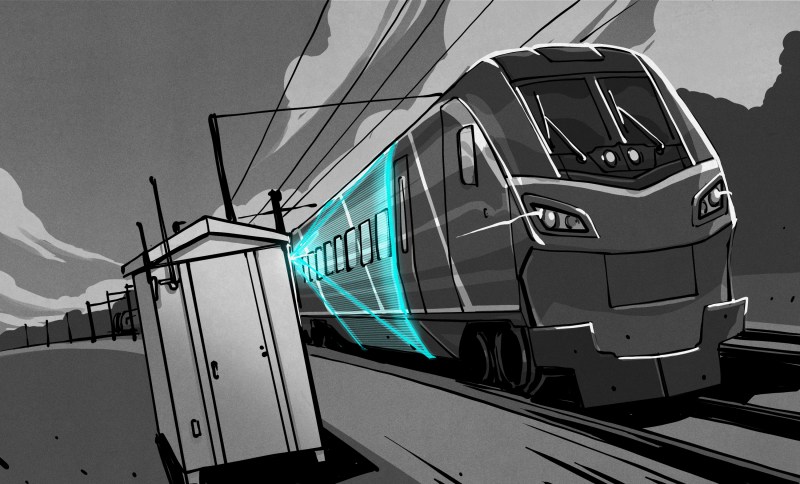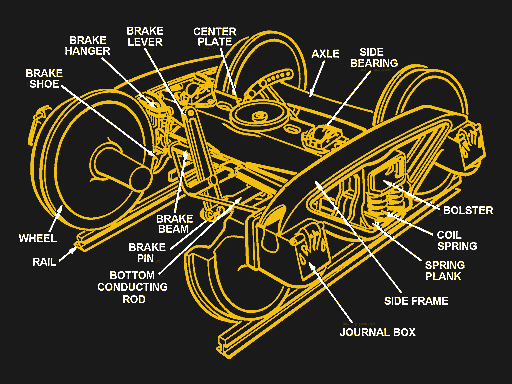
On the technology spectrum, railroads would certainly seem to skew toward the brutally simplistic side of things. A couple of strips of steel, some wooden ties and gravel ballast to keep everything in place, some rolling stock with flanged wheels on fixed axles, and you’ve got the basics that have been moving freight and passengers since at least the 18th century.
But that basic simplicity belies the true complexity of a railway, where even just keep keeping the trains on the track can be a daunting task. The forces that a fully loaded train can exert on not only the tracks but on itself are hard to get your head around, and the potential for disaster is often only a failed component away. This became painfully evident with the recent Norfolk Southern derailment in East Palestine, Ohio, which resulted in a hazardous materials incident the likes of which no community is ready to deal with.
Given the forces involved, keeping trains on the straight and narrow is no mean feat, and railway designers have come up with a web of sensors and systems to help them with the task of keeping an eye on what’s going on with the rolling stock of a train. Let’s take a look at some of the interesting engineering behind these wayside defect detectors.
Friction Is The Enemy

At the risk of stating the obvious, trains have two essential characteristics that make monitoring systems necessary: they’re heavy, and they’re long. The weight of a train is a problem because even though the basic architecture of a railway reduces rolling friction between a wheel and the ground, it does nothing to reduce friction between the railcar’s axles and the trucks that carry them. That’s the job of the wheel bearings, which like any other mechanical component are subject to wear, damage, and eventual failure, with the potential for catastrophic consequences.
As for the length of a train, that becomes a problem when it puts most of the rolling stock out of the direct visual range of the people running the train. Back in the day, limitations on locomotive power tended to keep trains relatively short, making it possible for conductors and engineers to keep an eye on every car. This was made easier by the invention of the caboose; in its classic configuration with a windowed cupola jutting up over the roof of the car and from its position at the very end of the train, conductors were able to observe the entire length of a train, especially on curves. Given that the wheel bearings of the day were often plain bushings in journal boxes stuffed with oil-soaked fibers, it was generally easy to spot a “hot box” bearing failure by the smoke and flames they emitted, as unsubtle an indicator of trouble as there ever was.
Engineering advances, like replacing plain bearings with roller bearings, made it possible to build ever-larger railcars. Freight cars operating on North American railways these days can have a gross weight of 315,000 pounds (143 tonnes), a mind-boggling amount of weight that’s carried by as few as eight roller bearings. Improvements in locomotive design have also allowed trains built from these supersized cars to get ever longer; the average freight train in 2017 was between 1.2 and 1.7 miles (1.9 to 2.7 kilometers) long, with some railroads regularly operating trains 3 miles (4.8 km) in length. On a train like that, anything more than a dozen or so cars back from the head-end locomotives is out of direct visual range of the engineer and conductor, and is effectively operating completely unobserved.
Eyes On The Rails
Wayside monitoring is the answer to the problems presented by scaling trains up to such massive dimensions. Collectively known in the railroad business as “defect detection,” the sensors and systems installed periodically along railroad tracks automatically scan for any problems with the rolling stock of a train that might result in an accident.

For good reason, the bulk of defect detection is focused on the condition of the wheels and bearings on each car in the train. And since friction is the enemy, most detectors key on the heat of these critical components to assess their condition. A typical wayside sensor installation will include both hot-box detectors (HBD) and hot-wheel detectors (HWD) on both rails. Both sensors are typically based on microbolometer arrays like those in thermal cameras. For HBDs, the sensors are typically mounted on the outside of the rail and pointing up, to get a good look at the bearing boxes on the end of each axle. HWDs are also typically mounted outside each rail, but they are aimed to look directly at the side of the wheel as it passes by. The thermal characteristics of wheels and bearings are quite different — wheels can get much hotter than bearings before counting as a defect — so HBDs and HWDs are calibrated differently.
Another detector present in most defect detection stations is the dragging equipment detector (DED). These are simply a series of paddles that are set up perpendicular to the rails. The paddles are mechanically connected to switches and are activated by anything that the train might be hanging down from the bottom of the train. The main target here is a disconnected air brake hose, but there are plenty of other hazards, everything from a broken truck to an unlucky animal. DEDs have to be extremely robust, as impacts with dragging equipment can exert a force of 600 g, and most DEDs are set up to work with trains moving in either direction.
Defect detection installations have become quite pervasive alongside North American railroads; there are something like 6,000 HBDs currently installed, or about one every 25 miles (40 km) of track. HBDs and HWDs can be a little hard to spot for railroad watchers, partly because they sit very low next to the track, but also because they need to be at least 300 feet (100 m) from a grade crossing, which is the only place most people get to see railroad tracks up close. Far easier to spot are the wayside bungalows that hold the equipment to which the sensors are connected. Bungalows look like little utility sheds next to the track, usually painted white or silver to reflect light and keep the temperature inside relatively constant. They contain racks for the electronic equipment that processes the signals from the detectors, along with support equipment like computers, power supplies, and backup batteries to keep the system powered even if grid power fails.
Defects On The Air
Once a defect is detected, what becomes of the information? A clue to that can be found on the wayside bungalow, which often has a conspicuous antenna mounted to it. Most seem to be a folded dipole antenna for either the VHF or UHF band, mounted vertically alongside the track and oriented to radiate parallel to it. Inside the bungalow, automated equipment uses a voice synthesizer to compose a report of the train’s condition, including any defects found, and transmits it to the train crew. Reports generally include the identification of the defect detector, the nature of the defect, and the axle or axles where the defect was detected. The train crew can then stop the train and walk back to the problem car and assess the nature of the problem.
Hot boxes, hot wheels, and dragging equipment aren’t the only kinds of wayside detectors in use, of course. It’s very common to monitor for mechanical defects on wheels, such as flat spots caused by an axle locking up and dragging the wheel on the rails. Flat spots cause excessive noise and equipment wear because of the impact they cause, and are detected by wheel-impact load detectors, or WILDs. These consist of a series of strain gauges attached to long stretches of track, which record the high-g vertical impacts generated by out-of-round or otherwise damaged wheels and alert the train crew. Other detectors are focused on the status of the rolling stock trucks, to make sure the axles are in proper alignment with the track and not engaged in “track hunting,” a lateral oscillation of the wheelset on the tracks as it seeks an equilibrium point. Hunting can result in damage to the wheel flanges, the track, and can even cause derailment if the oscillation causes the car to sway too much.
As you can imagine, all this equipment requires a lot of resources to install and maintain. Defect detection systems are widely distributed, with installations often dozens to hundreds of miles apart, meaning that technicians trained to work on them are spread thinly and often have to travel to remote locations to work on the systems. It’s worth it, though — since 1980, trains accidents related to axle and wheel failures have decreased 81% due to the widespread use of hotbox detectors.
Feeling the Heat: Railway Defect Detection
Source: Manila Flash Report
0 Comments